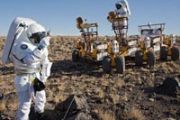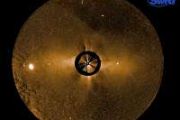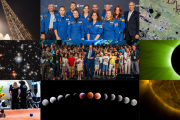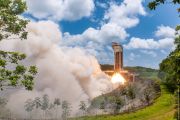
Copernical Team
Final preparations for Biomass operations
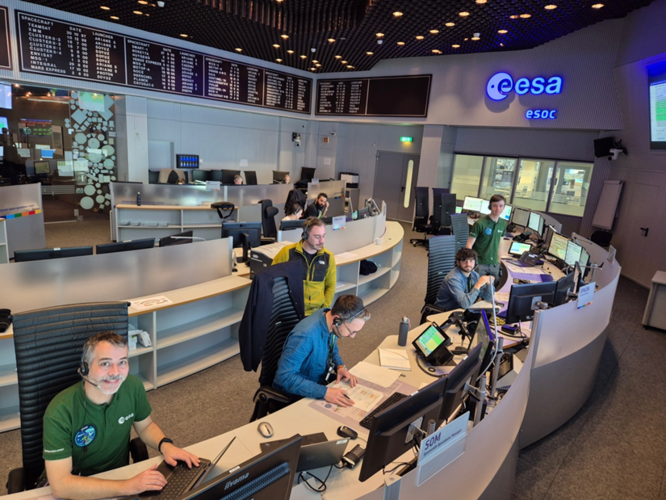
As the launch of the Biomass satellite approaches, the excitement is palpable at ESA’s European Space Operations Centre (ESOC) in Darmstadt, Germany. Over the winter months, a dedicated team has been meticulously preparing for the satellite's critical "Launch and Early Orbit" phase (LEOP).
New study unveils volcanic history and clues to ancient life on Mars
 In a groundbreaking study co-authored by a Texas A and M University scientist, researchers have revealed new insights into the geological history of Mars' Jezero Crater, the landing site of NASA's Perseverance rover. Their findings suggest that the crater's floor is composed of a diverse array of iron-rich volcanic rocks, providing a window into the planet's distant past and the closest chance y
In a groundbreaking study co-authored by a Texas A and M University scientist, researchers have revealed new insights into the geological history of Mars' Jezero Crater, the landing site of NASA's Perseverance rover. Their findings suggest that the crater's floor is composed of a diverse array of iron-rich volcanic rocks, providing a window into the planet's distant past and the closest chance y Planetary Alignment Provides NASA Rare Opportunity to Study Uranus
 When a planet's orbit brings it between Earth and a distant star, it's more than just a cosmic game of hide and seek. It's an opportunity for NASA to improve its understanding of that planet's atmosphere and rings. Planetary scientists call it a stellar occultation and that's exactly what happened with Uranus on April 7.
Observing the alignment allows NASA scientists to measure the tempera
When a planet's orbit brings it between Earth and a distant star, it's more than just a cosmic game of hide and seek. It's an opportunity for NASA to improve its understanding of that planet's atmosphere and rings. Planetary scientists call it a stellar occultation and that's exactly what happened with Uranus on April 7.
Observing the alignment allows NASA scientists to measure the tempera Turning Down Starlight to Reveal Distant Worlds
 Researchers at the University of Arizona have introduced a breakthrough coronagraph that could make previously invisible exoplanets detectable by suppressing the overwhelming light from their parent stars. This advance may pave the way for imaging Earth-like planets in habitable zones, areas where temperatures could support liquid water and potentially life.
"Earth-like planets in the habi
Researchers at the University of Arizona have introduced a breakthrough coronagraph that could make previously invisible exoplanets detectable by suppressing the overwhelming light from their parent stars. This advance may pave the way for imaging Earth-like planets in habitable zones, areas where temperatures could support liquid water and potentially life.
"Earth-like planets in the habi NASA develops flight-ready aerogel antennas for next-gen airspace communications
 NASA is advancing flight communications with a breakthrough antenna made from one of the lightest solid materials ever created. Engineers at NASA's Glenn Research Center are embedding this innovative device directly into aircraft surfaces, offering a sleeker and more efficient solution for future aviation platforms, including autonomous air vehicles and drones.
The antenna employs a polyme
NASA is advancing flight communications with a breakthrough antenna made from one of the lightest solid materials ever created. Engineers at NASA's Glenn Research Center are embedding this innovative device directly into aircraft surfaces, offering a sleeker and more efficient solution for future aviation platforms, including autonomous air vehicles and drones.
The antenna employs a polyme How Webb Telescope Opens New Avenues in the Quest for Extraterrestrial Life
 NASA's James Webb Space Telescope is ushering in a transformative chapter in the pursuit of life beyond Earth. Although Webb was not purpose-built for life detection, its remarkable capabilities in infrared observation are enabling scientists to examine small, rocky exoplanets orbiting distant stars with an unprecedented level of detail.
Webb is uniquely equipped to detect atmospheres arou
NASA's James Webb Space Telescope is ushering in a transformative chapter in the pursuit of life beyond Earth. Although Webb was not purpose-built for life detection, its remarkable capabilities in infrared observation are enabling scientists to examine small, rocky exoplanets orbiting distant stars with an unprecedented level of detail.
Webb is uniquely equipped to detect atmospheres arou Scientists investigate absence of sediment deltas on Titan
 NASA's Mars missions have shown that sediment-rich deltas offer valuable insights into a planet's climate and geologic past. Yet on Saturn's moon Titan, where vast rivers of methane and ethane flow, scientists have found a puzzling lack of such features. A new study from Brown University is shedding light on this enigma.
Titan is the only body in the solar system besides Earth with stable
NASA's Mars missions have shown that sediment-rich deltas offer valuable insights into a planet's climate and geologic past. Yet on Saturn's moon Titan, where vast rivers of methane and ethane flow, scientists have found a puzzling lack of such features. A new study from Brown University is shedding light on this enigma.
Titan is the only body in the solar system besides Earth with stable Students test compact reentry glider to advance hypersonic research
 A team of fourth-year mechanical and aerospace engineering students at the University of Virginia aims to pioneer a new low-cost method for gathering hypersonic flight data. Their innovative glider, called HEDGE (Hypersonic ReEntry Deployable Glider Experiment), is set to launch aboard a NASA suborbital rocket this August from the Wallops Flight Facility in Virginia.
Part of their senior c
A team of fourth-year mechanical and aerospace engineering students at the University of Virginia aims to pioneer a new low-cost method for gathering hypersonic flight data. Their innovative glider, called HEDGE (Hypersonic ReEntry Deployable Glider Experiment), is set to launch aboard a NASA suborbital rocket this August from the Wallops Flight Facility in Virginia.
Part of their senior c First microbes blast off testing production of food for space travel
 Scientists from Imperial College London have embarked on a mission to test how engineered microbes can help sustain future spacefarers on interplanetary voyages.
As space agencies and private companies aim for distant planets, the logistics of carrying food, water, and fuel become increasingly costly and complex. Feeding one astronaut in orbit can cost up to Pounds 20,000 per day. To addr
Scientists from Imperial College London have embarked on a mission to test how engineered microbes can help sustain future spacefarers on interplanetary voyages.
As space agencies and private companies aim for distant planets, the logistics of carrying food, water, and fuel become increasingly costly and complex. Feeding one astronaut in orbit can cost up to Pounds 20,000 per day. To addr Current hurdles and technological roadmap for processing lunar hyperspectral orbiter data
 Spectral imagers have become vital tools in the quest to unravel the Moon's mineralogical makeup, playing a central role in today's lunar science missions. As interest grows in acquiring higher-quality remote sensing data, demands are increasing for instruments capable of capturing broader wavelength ranges with finer spectral and spatial resolution. Yet these technical gains bring a suite of da
Spectral imagers have become vital tools in the quest to unravel the Moon's mineralogical makeup, playing a central role in today's lunar science missions. As interest grows in acquiring higher-quality remote sensing data, demands are increasing for instruments capable of capturing broader wavelength ranges with finer spectral and spatial resolution. Yet these technical gains bring a suite of da 










